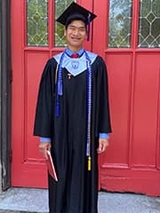Surgery for Cleft Lip and Palate: Dan’s Story
Surgery for Cleft Lip and Palate: Dan’s Story
As an adopted toddler, Dan came from China to Children's Hospital of Philadelphia (CHOP), where the multidisciplinary cleft palate team provided peak care for the next 18 years of his life. The multiple procedures he has undergone include a recent jaw surgery that had major implications for his appearance.

Dan is no stranger to surgery. He was barely 2 when he had the first procedure to correct his cleft lip in China, where he was born. Within three weeks of being adopted and flown to his new home in Bucks County, Pennsylvania, Dan was meeting with the multidisciplinary Cleft Lip and Palate Program team at CHOP.
For the next 15 years he was a regular at CHOP, undergoing several more procedures to correct his palate, and related issues, as his facial bones grew. But even with all his experience, facing the final jaw surgery at age 17 gave him pause — and it had nothing to do with the usual pre-op jitters.
“The pain part I wasn’t nervous about,” he says. “But with this surgery, your face looks super different afterward.” Because the procedure changes the position of the upper and lower jaw, it can greatly affect a patient’s appearance, especially their profile, which is often somewhat flattened in patients with cleft palate. As a teenager just getting comfortable with his looks, that was “pretty daunting and scary,” Dan says. In addition, it would take a very long time — in Dan’s case, nearly an entire year — for the post-surgical swelling to go down enough for him to even know exactly what his new face would look like.
Dan’s team at CHOP included a psychologist, who met with him as he made his decision — and it was entirely his decision, says his mother, Peggy. Ultimately, Dan says, “I didn’t really think too hard about how I would look, I just trusted the fact that I would look better.”
“Jaw surgery, especially that done for a large underbite, has tremendous benefits for both function and appearance,” explains Jesse Taylor, MD, Chief of the Division of Plastic, Reconstructive and Oral Surgery, Co-Director of the Cleft Lip and Palate Program, and Co-Director of the Craniofacial Program. “Going through jaw surgery is no small feat, however, and because we wait until after kids are done growing, they go through it when they are most busy with extracurricular activities — that is, when it is ‘least convenient.’ Dan has proven to be both courageous and stoic, and we are honored that he is sharing his journey so honestly with others.”
A team effort
Dan’s cleft palate team at CHOP was a big part of his confidence in his decision. The multidisciplinary group, who he had been seeing since he was a toddler, included not only a therapist and social worker, but also Dan’s ear/nose/throat specialist, pediatrician, plastic surgeon and orthodontist. “You meet with everyone once a year for a ‘team day,’” says Peggy. “They do exams, tests, take pictures, and then provide a synopsis of recommendations. It’s so state of the art. Other places around the country do this surgery, but it's very segmented.”
Jaw surgery was, for Dan, the culmination of a series of procedures. Typically, surgeries are required to repair cleft lip and palate, followed by orthodontic intervention to widen the palate, if needed (and Dan did). In many patients, including Dan, cleft palate also affects an area of bone that forms the gumline called the alveolar, which means they also need a bone graft around the time they begin losing their baby teeth. This is followed by more orthodontics, and finally, jaw surgery to align the upper and lower jaw and correct what is usually an underbite.
A practicing anesthetist, Peggy was familiar with the surgical procedures for repairing cleft lip and cleft palate, but Dan’s journey was the first time she experienced it as a mother. It would not be the last, though: Dan was the sixth of Peggy and her husband Mark’s nine children, and three of his younger siblings, all also adopted from China, were born with the same condition.

“What is most amazing to me is that Dan’s adoptive parents, Peggy and Mark, had four biologic children before they adopted five more,” says David Low, an attending surgeon in the Division of Plastic, Reconstructive and Oral Surgery who was part of Dan’s team. “Dan is the oldest of four adopted Chinese children with clefts, and he has been a wonderful example for his younger siblings. It has been an inspirational privilege to have cared for all of them in our Cleft and Craniofacial Program.”
Worldwide, around 1 in 700 babies are born with orofacial clefts (lip and/or palate). Cleft defects tend to occur more frequently in boys and people of Asian descent. It is the result of parts of the mouth not fully forming in utero, leaving an opening in the roof of the mouth that can cause difficulty eating, breathing and speaking.
Typically, surgery to repair this opening is recommended in the first year of a child’s life, but Dan was close to 3 when Peggy brought him to CHOP. “Every time he would eat, food would come out his nose,” she says. “And his ear canals were filled with fluid, which is typical for kids with cleft palate and cleft lip. It affected his hearing, so ear tubes were placed to drain the fluid.” As she met with the team with Dan on her lap, she recalls thinking, “I can’t believe this little boy went from this tiny clinic in China to the top pediatric hospital in the country. We are beyond grateful for CHOP and the cleft palate team. I don’t know what we would do if we didn’t live in Philadelphia.”
Progress, not perfection
Dan and Peggy continued to meet with the CHOP team yearly. As Dan grew, assessments showed that although the surgery repaired his palate, Dan’s cleft also affected the thin layer of bone in his upper gumline. This bone, known as the alveolus, is where his permanent teeth would be, so it was necessary for him to undergo another procedure. Around age 6, Dan had a bone graft, where tissue from his hip was used to repair his palate and provide a place for his new teeth to come in.
“One of the biggest parts of fixing a cleft palate and cleft lip is orthodontics,” says Peggy. Dan had to wear a palate expander for six months to ready himself for another surgery. “Every two or three days, you’d have to use a key to turn the expander and widen it,” Peggy says. Dan remembers the sensation as unpleasant, but not painful. “My mouth felt very full,” he says. The expander also impeded his speech somewhat, for which he attended speech therapy at school until around fifth grade.
The following year, at age 13, Dan got his first set of braces. He’s worn them up until this year when, at age 20, he finally got them removed.
Jaw surgery makes the biggest change
But for Dan, the biggest change — and challenge — was jaw surgery at age 17. The recovery was challenging; he had to breathe through his nose and could only take in fluids for days afterward. “I think Dan lost about 15 pounds in a week,” Peggy says. His siblings took turns getting him milkshakes until he could handle solid foods, then switched to mashed potatoes and mac-and-cheese. Chewing, Dan says, was hard to get used to. “I remembered how I used to eat, and it felt like I was a different person. My face didn’t move how it used to.”

But harder still was the fact that for the first six months post-op, “I didn’t like how I looked,” he says. “It was hard to get used to.” Eventually, though, after the swelling subsided and Dan had what he calls “a lot of introspection about how I looked,” he settled into his new face. “I had had a huge underbite,” he says. “Now that I have more of an even bite, it’s easier to eat. I’m really grateful.”
“Dan looks amazing,” says Peggy. He was invited to be one of the models in CHOP’s fundraising fashion show, called The Runway, which in 2021 benefited CHOP’s Division of Plastic, Reconstructive and Oral Surgery. It was an experience he says was interesting — in part, because he shared the stage with a dog named Lentil that had had the same surgery as him. Lentil had been treated for cleft palate and cleft lip at Penn Vet.
Today, Dan is an honors engineering student at Temple University, and he hopes to be a role model for his younger siblings who are going through the same process, with the same team at CHOP. “It definitely helps to have someone going through it with you,” he says. “I like that I can be the older person who’s going through it with them.”